|
|
|
Sort Order |
|
|
|
Items / Page
|
|
|
|
|
|
|
| Srl | Item |
| 1 |
ID:
112235


|
|
|
|
|
| Publication |
2012.
|
| Summary/Abstract |
The market scale of China's wind turbine manufacturing industry has grown immensely. Despite China still having a limited capacity in terms of technology innovation, the institutional support has promoted the technology capability development of the wind turbine manufacturing industry. This paper explores the driving forces underlying this development by reviewing the transition of the innovation modes and the dynamic interactions among the technology capability, innovation modes, market formation, and wind energy policy. The innovation mode in China began with imitative innovation, then transitioned to cooperative innovation, and has more recently set its sights on attaining truly indigenous innovation. Public policy serves as a key driving force for the evolution of innovation modes, as well as the development of the market. The policy focus has evolved in the following sequence: 1. building the foundation for technological innovation; 2. encouraging technology transfer; 3. enhancing local R&D and manufacturing capabilities; 4. enlarging the domestic market; and 5. cultivating an open environment for global competition and sustainable market development in China.
|
|
|
|
|
|
|
|
|
|
|
|
|
|
|
|
| 2 |
ID:
112266
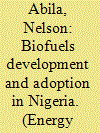

|
|
|
|
|
| Publication |
2012.
|
| Summary/Abstract |
Biofuels development and adoption in Nigeria has progressed significantly since the inception of the country's biofuel program in 2007. The rapid growth of the biofuels subsector in Nigeria inspired this review which aims at identifying the key drivers, agents, enablers, incentives and objectives driving the development. From the upstream to the downstream sub-sectors, there is an increasing entry of players and participants (private and public investors). This paper aims to explore the underlining drivers, enablers and incentives promoting the investments and participations in biofuels development, adoption and utilization in Nigeria. The research sourced data from basically secondary sources and undertook desk review of available information. The drivers identified are classified into the endogenous and exogenous categories. From the review, the paper presents a multi-components conceptual framework that captures key elements of the biofuel development in Nigeria.
|
|
|
|
|
|
|
|
|
|
|
|
|
|
|
|
| 3 |
ID:
112254


|
|
|
|
|
| Publication |
2012.
|
| Summary/Abstract |
The current status and legal framework of biogas production in Portugal are analyzed and compared to that of five other European countries, characterized by wide-ranging diversity of substrates and biogas applications. With this comparison, and with the calculation of the biogas energy potential in Portugal, the authors want to assess the significance of developing the Portuguese biogas sector. This study illustrates that the highest biogas feed-in tariffs are applied in the countries with a more developed sector. In Portugal, despite the fact that the organic effluents are a relevant energy source (873 Mm3 biogas per year; 4889 GW h yr-1) and that new feed-in tariffs were established, biogas valorisation is still at an early stage. The importance of anaerobic digestion was only recognized in 2007 and the present installed power is about 10% of the potential electrical power (229 MW). Therefore, it is desirable to strengthen the national and regional biogas market.
|
|
|
|
|
|
|
|
|
|
|
|
|
|
|
|
| 4 |
ID:
112272


|
|
|
|
|
| Publication |
2012.
|
| Summary/Abstract |
The pulp and paper industry is a significant consumer of fossil energy in the Taiwanese manufacturing sector. The concentration of greenhouse gases (GHG) from manufacturing factory activities and vehicle emissions has increased remarkably. Notable energy savings can be achieved in the pulp and paper industry through energy flow analysis. The aim of this paper is to analyze the energy flow for three major energy consuming mills of the pulp and paper industry in Taiwan to make energy savings. In addition, potential technology options are examined for the capture of some of the energy that is currently lost in the processes and to identify the areas of energy saving potential that could have a large impact across more than one industry. The results of this study can serve as a benchmark for developing a quantified list in terms of energy savings potential and opportunities for improving the efficiency of the pulp and paper industry.
|
|
|
|
|
|
|
|
|
|
|
|
|
|
|
|
| 5 |
ID:
112234


|
|
|
|
|
| Publication |
2012.
|
| Summary/Abstract |
Global warming is likely to profoundly influence future weather patterns, and one consequence of this is the likelihood of an increase in tropical cyclone intensity. The present paper presents a cost-benefit analysis of introducing significant amounts of green energy in the electricity system in Japan in the light of the economic damage that an increase in tropical cyclone intensity could have on GDP growth between 2010 and 2085. Essentially the passage of a tropical cyclone will result not only in physical damage but also on a decrease in economic productivity due to precautionary cessation of the economic activity, which has an effect on GDP growth. By comparing the economic performance of different electricity system scenarios with the indirect economic damage of tropical cyclones from 2010 to 2085, based on the yearly economic data of green electricity, fossil fuel, GDP and population, it can be seen that the green scenarios are generally a cost-effective way of mitigating the effects of these weather systems, despite the large amount of initial investments necessary.
|
|
|
|
|
|
|
|
|
|
|
|
|
|
|
|
| 6 |
ID:
112251


|
|
|
|
|
| Publication |
2012.
|
| Summary/Abstract |
This study explores the relationships between metropolis energy consumption and environmental utility changes by a proposed Environmental Utility of Energy Consumption (EUEC) model. Based on the dynamic equilibrium of input-output economics theory, it considers three simulation scenarios: fixed-technology, technological-innovation, and green-building effect. It is applied to analyse Hong Kong in 1980-2007. Continual increase in energy consumption with rapid economic growth degraded environmental utility. First, energy consumption at fixed-technology was determined by economic outcome. In 1990, it reached a critical balanced state when energy consumption was 22×109 kWh. Before 1990 (x1<22×109 kWh), rise in energy consumption improved both economic development and environmental utility. After 1990 (x1>22×109 kWh), expansion of energy consumption facilitated socio-economic development but suppressed environmental benefits. Second, technological-innovation strongly influenced energy demand and improved environmental benefits. The balanced state remained in 1999 when energy consumption reached 32.33×109 kWh. Technological-innovation dampened energy consumption by 12.99%, exceeding the fixed-technology condition. Finally, green buildings reduced energy consumption by an average of 17.5% in 1990-2007. They contributed significantly to energy saving, and buffered temperature fluctuations between external and internal environment. The case investigations verified the efficiency of the EUEC model, which can effectively evaluate the interplay of energy consumption and environmental quality.
|
|
|
|
|
|
|
|
|
|
|
|
|
|
|
|
| 7 |
ID:
112274


|
|
|
|
|
| Publication |
2012.
|
| Summary/Abstract |
In the power sector, technological change is a key lever to address the decarbonisation needed to avoid dangerous climate change. Policy makers aim to accelerate and redirect technological change by targeting relevant firms via climate policy, e.g., the European Union Emissions Trading System (EU ETS), and climate-relevant technology policies, e.g., feed-in tariffs. Changes in firm's behaviour, i.e., their research and development (R&D) as well as diffusion activities, are at the heart of technological change. However, firms are heterogeneous actors with varying attributes which perceive policy differently. Hence, they can be expected to react very heterogeneously to these new policies. Based on an original dataset of 201 firms, we perform a cluster analysis grouping firms along their R&D and diffusion activity changes. We then compare these clusters with regards to the characteristics of the contained firms. Our analysis results in seven clusters showing very diverse contributions to low-carbon technological change, suggesting potential for policy to become more effective. A comparison of the firms' characteristics allows us to derive indicative recommendations on how to adjust the policy mix in order to induce contributions from most firms in the power sector.
|
|
|
|
|
|
|
|
|
|
|
|
|
|
|
|
| 8 |
ID:
112256
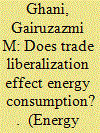

|
|
|
|
|
| Publication |
2012.
|
| Summary/Abstract |
The effect of trade liberalization on the environment can be directly linked to energy consumption, because energy consumption and production are the underlying cause of most pollutants that harm the environment. The descriptive statistics show that average annual growth of energy consumption per capita after trade liberalization varies among countries; hence it is a possibility that the effect of trade liberalization is conditional on factors other than liberalization per se. The regression results show that trade liberalization per se does not affect the growth of energy consumption of the developing countries analyzed, but its interaction with capital per labor reduces the growth of energy consumption as capital per labor increases. However, the effect is only significant after a certain minimum threshold level capital per labor is reached. On the other hand, economic growth increases energy consumption and its effect is not conditioned on trade liberalization. These two different effects mean that, with regards to energy consumption, countries at a higher level of economic development are more likely to reap the benefit of liberalization relative to less developed countries.
|
|
|
|
|
|
|
|
|
|
|
|
|
|
|
|
| 9 |
ID:
112244


|
|
|
|
|
| Publication |
2012.
|
| Summary/Abstract |
The aim of this paper is to examine the economic impact of the royalty reform. The draft Turkish petroleum Law introduces two important fiscal changes to increase to increase domestic petroleum production, further national petroleum supply, attract investors and harmonize its laws with those of the European Community: (1) progressive sliding royalty relief on oil and gas production leases and (2) 50% of the royalty shall be transferred to province where the production lease exists.Results included in this analysis indicate that there would be 2% increase in oil production thanks to 128 oil fields extending economic life and 0.5% increase in gas production thanks to 63 gas fields due to their profitability in the forecasted period. Half of royalty is transferred to low per capita income provinces and tends to contribute distribution of income. However, half of gas royalty is transferred to high income per capita provinces.
|
|
|
|
|
|
|
|
|
|
|
|
|
|
|
|
| 10 |
ID:
112267


|
|
|
|
|
| Publication |
2012.
|
| Summary/Abstract |
Small nuclear reactors align well with the small heat-capacity needs for many European process industries. Combined heat and power (CHP) reactors can support the EU low-carbon society goals while providing stability in production and cost. High temperature reactor technologies are well suited for the production of "high value" heat by producing temperatures of 200-550 °C. However, little is known about the market potential or economic competitiveness of these reactors in future European cogeneration markets. This study shows that the greatest potential is in chemical/petroleum, paper, metal, and bioenergy markets with small capacities (50-250 MWth). Target market costs for coal-CHP and natural gas-CHP were determined to range from 60-100 €/MWh and 95-208 €/MWh, respectively. Costs for "heat-only" ranges from 30-60 €/MWh based on gas boilers. Parametric analysis was used to create a cost breakdown (capital, operations and maintenance, fuel, and decommissioning) for an equivalent nuclear CHP that could compete against coal-CHP and natural gas-CHP. Sensitivity analysis showed that reactor capital costs and the costs of capital had the largest influence on competitiveness. In summary, the opportunities for nuclear CHP are highest in natural gas-CHP markets; however the benefits for CO2 reduction were greatest against coal-CHP.
|
|
|
|
|
|
|
|
|
|
|
|
|
|
|
|
| 11 |
ID:
112241
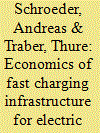

|
|
|
|
|
| Publication |
2012.
|
| Summary/Abstract |
By 2011 little is known about the economic rationale of public fast chargers for electric vehicles (EV). This paper aims at providing an insight into the business case of this technology in a case study for Germany. The estimated Return on Investment (ROI) of a public fast charging station constitutes the main contribution. Potential users and organization structures are investigated as well as different tariff types. According to the estimations, the current market outlook seems too uncertain for triggering a large-scale roll-out of fast charging infrastructure. Approximations suggest that investment is hardly profitable at low EV adoption rates, unless investment cost can be severely lowered. Besides competition with alternative charging solutions, the general EV adoption rate is detected as being a main risk factor for investment in public charging infrastructure.
|
|
|
|
|
|
|
|
|
|
|
|
|
|
|
|
| 12 |
ID:
112268


|
|
|
|
|
| Publication |
2012.
|
| Summary/Abstract |
We adopted the refined Laspeyres index approach to explore the impacts of industry scale, energy mix, energy intensity and utility mix on the total carbon dioxide emissions from the Chinese nonferrous metals industry for the period 1996-2008. In addition, we calculated the trend of decoupling effects in nonferrous metals industry in China by presenting a theoretical framework for decoupling. As the results suggest, Chinese nonferrous metals industry has gone through four decoupling stages: strong negative decoupling stage (1996-1998), weak decoupling stage (1999-2000), expensive negative decoupling stage (2001-2003) and weak decoupling stage (2004-2008). We have analyzed the reasons for each phase. Generally speaking, the rapid growth of the industry is the most important factor responsible for the increase of CO2 emissions, and the change in energy mix was mainly due to the increased proportion of electric energy consumption that has contributed to the increase of CO2 emissions. Reduction of energy intensity has contributed significantly to emissions decrease, and the utility mix effect has also contributed to the emission decrease to some extent.
|
|
|
|
|
|
|
|
|
|
|
|
|
|
|
|
| 13 |
ID:
112243
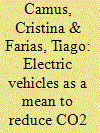

|
|
|
|
|
| Publication |
2012.
|
| Summary/Abstract |
Most of small islands around the world today, are dependent on imported fossil fuels for the majority of their energy needs especially for transport activities and electricity production. The use of locally renewable energy resources and the implementation of energy efficiency measures could make a significant contribution to their economic development by reducing fossil fuel imports. An electrification of vehicles has been suggested as a way to both reduce pollutant emissions and increase security of supply of the transportation sector by reducing the dependence on oil products imports and facilitate the accommodation of renewable electricity generation, such as wind and, in the case of volcanic islands like São Miguel (Azores) of the geothermal energy whose penetration has been limited by the valley electricity consumption level. In this research, three scenarios of EV penetration were studied and it was verified that, for a 15% LD fleet replacement by EVs with 90% of all energy needs occurring during the night, the accommodation of 10 MW of new geothermal capacity becomes viable. Under this scenario, reductions of 8% in electricity costs, 14% in energy, 23% in fossil fuels use and CO2 emissions for the transportation and electricity production sectors could be expected.
|
|
|
|
|
|
|
|
|
|
|
|
|
|
|
|
| 14 |
ID:
112249


|
|
|
|
|
| Publication |
2012.
|
| Summary/Abstract |
Despite three decades of reform, the electric power industry in China is still organised by a partial reformed plan system, where the investment to build capacity has been liberalised, but the prices and the production remain controlled by the state. This paper examines the pricing behaviour of the power supply in China, where the state attempts to balance the interest between the public and the electric power industry. The empirical evidence shows that the cost factors are critical to the electricity pricing in China, and that the bargaining mechanism, which sets the plan price, allows the power producers to face a soft budget constraint on their own costs.
|
|
|
|
|
|
|
|
|
|
|
|
|
|
|
|
| 15 |
ID:
112260


|
|
|
|
|
| Publication |
2012.
|
| Summary/Abstract |
Fast economic growth in China has generated energy and environmental problems. Fixed-asset investments have contributed significantly to energy consumption. In China, an energy conservation assessment (ECA), a mechanism similar to the existing environmental impact assessment (EIA), has been applied to improve the energy efficiency of new fixed-asset investment projects. In this paper the origin and development of the ECA system is analyzed and the major features of ECA are discussed. To identify the success and failure of the ECA system, case studies are analyzed and comparison between ECA and EIA, which has been used in China for over 30 years, is made. Based on the analysis, recommendations are provided for the improvement of the ECA system in China. Despite the ECA system only being established for a relatively short time, it has clearly achieved significant success. With further efforts it could play an important role in achieving the goals of improving China's energy efficiency and reducing green house gas emissions.
|
|
|
|
|
|
|
|
|
|
|
|
|
|
|
|
| 16 |
ID:
112265


|
|
|
|
|
| Publication |
2012.
|
| Summary/Abstract |
The development of total energy consumption is important in a world with limited resources. It is the result of two basic tendencies working in opposite directions: growth in number and in use (such as more cars and driving more) and improvements in energy efficiency (such as more fuel-efficient engines). Since the 1970s growth of energy consumption has slowed down in Sweden. This means that increasing supply has been counteracted by measures improving overall energy efficiency to a larger degree than before. How can long-term development in energy consumption be analysed? This paper proposes a focus on stocks of energy-converting artefacts as a tool for such analyses. In order to show the fruitfulness of this approach, historical data on cars, dwellings and lamps in Sweden are used.
Results from the cases in this paper show considerable gains of efficiency in fuel consumption in private cars and heating efficiency in multi-dwelling houses. Demographic factors are important for the outcome. The approach seems to promise a way to analyse energy efficiency that captures both promoting and counteracting factors at both the micro and macro level.
|
|
|
|
|
|
|
|
|
|
|
|
|
|
|
|
| 17 |
ID:
112263
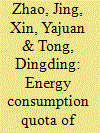

|
|
|
|
|
| Publication |
2012.
|
| Summary/Abstract |
The establishment of building energy consumption quota as a comprehensive indicator used to evaluate the actual energy consumption level is an important measure for promoting the development of building energy efficiency. This paper focused on the determination method of the quota, and firstly introduced the procedure of establishing energy consumption quota of public buildings including four important parts: collecting data, classifying and calculating EUIs, standardizing EUIs, determining the measure method of central tendency. The paper also illustrated the standardization process of EUI by actual calculation based on the samples of 10 commercial buildings and 19 hotel buildings. According to the analysis of the frequency distribution of standardized EUIs of sample buildings and combining the characteristics of each measure method of central tendency, comprehensive application of mode and percentage rank is selected to be the best method for determining the energy consumption quota of public buildings. Finally the paper gave some policy proposals on energy consumption quota to help achieve the goal of further energy conservation.
|
|
|
|
|
|
|
|
|
|
|
|
|
|
|
|
| 18 |
ID:
112242


|
|
|
|
|
| Publication |
2012.
|
| Summary/Abstract |
There are several major federal nuclear facilities located in small towns and rural areas of the United States. While many of these facilities were developed in the 1950s to support national defense, in the 1960s and 1970s, some of these shifted their mission to focus on national energy infrastructure. Now, many of these facilities are in a clean-up phase, and local communities are becoming increasingly engaged in influencing decisions about the future of the sites. Communicating with the public in rural communities is challenging when it involves a complicated environmental issue that could have widespread economic impacts. The local media reflect public understanding, so getting a sense of how these media frame issues can be a crucial first step to developing an effective community engagement strategy. A media content analysis of one local newspaper was completed in relation to a major federal nuclear facility. The content analysis is compared to the results of a telephone survey in the region served by the paper and the results suggest that there is a relationship between how the facility is portrayed in local media and public concern. This study has important implications for other nuclear facilities because of the role of local citizens in decision-making.
|
|
|
|
|
|
|
|
|
|
|
|
|
|
|
|
| 19 |
ID:
112252


|
|
|
|
|
| Publication |
2012.
|
| Summary/Abstract |
We established a bottom-up model to deliver the future trends of fuel consumption and life cycle greenhouse gas (GHG) emissions by China's on-road trucks. The mitigation measures of mileage utilization rate (MUR) improvement, fuel consumption rate (FCR) improvement, and penetration of liquefied natural gas (LNG) fueled trucks were evaluated. With no mitigation measures implemented, in the year 2050, the total fuel consumption and life cycle GHG emissions by China's on-road trucks were projected to reach 498 million toe and 2125 million tons, respectively, approximately 5.2 times the level in 2010. If the MUR of trucks in China is increased from the current status as those of the developed countries, a 13% reduction of total fuel consumption can be achieved after 2020. If the FCR of trucks is reduced by 10% in 2011, 2016, 2021, and 2026, a 30% reduction of total fuel consumption can be achieved after 2030. Moreover, if the share of LNG fueled trucks in all newly registered semi-trailer towing trucks and heavy-duty trucks is increased to 20% in 2030, an estimate of 7.9% and 10.9% of the total diesel consumption by trucks will be replaced by LNG in 2030 and 2050, respectively.
|
|
|
|
|
|
|
|
|
|
|
|
|
|
|
|
| 20 |
ID:
112258


|
|
|
|
|
| Publication |
2012.
|
| Summary/Abstract |
Sustainable development has become an important part of international and national approaches to integrate economic, environmental, social and ethical considerations so that a good quality of life can be enjoyed by current and future generations for as long as possible. However, nowadays sustainable development is threatened by industrial pollution emissions which cause serious environmental problems. Due to a lack of adequate quantitative models for environmental policy analysis, there is a strong need for analytical models in order to know the effects of environmental policies. In the present paper, a goal programming model, based on an environmental/input-output linear programming model, is developed and applied to the Spanish economy. The model combines relations between economic, energy, social and environmental effects, providing valuable information for policy-makers in order to define and examine the different goals that must be implemented to reach sustainability.
|
|
|
|
|
|
|
|
|
|
|
|
|
|
|
|
|
|
|
|
|